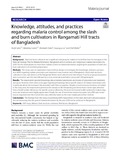| dc.contributor.author | Saha, Avijit | |
| dc.contributor.author | Sarker, Malabika | |
| dc.contributor.author | Kabir, Moktadir | |
| dc.contributor.author | Lu, Guangyu | |
| dc.contributor.author | Müller, Olaf | |
| dc.date.accessioned | 2022-03-30T06:53:11Z | |
| dc.date.available | 2022-03-30T06:53:11Z | |
| dc.date.copyright | 2019 | |
| dc.date.issued | 2019-06-25 | |
| dc.identifier.citation | Saha, A., Sarker, M., Kabir, M., Lu, G., & Müller, O. (2019). Knowledge, attitudes, and practices regarding malaria control among the slash and burn cultivators in Rangamati hill tracts of Bangladesh. Malaria Journal, 18(1) doi:10.1186/s12936-019-2849-0 | en_US |
| dc.identifier.uri | http://hdl.handle.net/10361/16490 | |
| dc.description | This article was published in the BMC Malaria Journal [© The Author(s) 2019. This article is distributed under the terms of the Creative Commons Attribution 4.0 International License (http://creativecommons.org/licenses/by/4.0/)] and the definite version is available at: https://doi.org/10.1186/s12936-019-2849-0 The Journal's website is at: https://malariajournal.biomedcentral.com/articles/10.1186/s12936-019-2849-0#citeas | en_US |
| dc.description.abstract | Abstract
Background: Slash and burn cultivators are a signifcant risk group for malaria in South-East Asia. As envisaged in the
National Strategic Plan for Malaria Elimination, Bangladesh aims to achieve zero indigenous malaria transmission by
2030. For the national plan to move from malaria control to malaria elimination, targeting the population of slash and
burn cultivators is of overriding importance.
Methods: The study used an explorative mixed method design to investigate the knowledge, attitudes, and practices (KAP) regarding malaria prevention and treatment in an endemic area of Bangladesh. Adult slash and burn
cultivators in two sub-districts of the Rangamati District were selected and interviewed. Four focus group discussions
were conducted, and this was followed by a cross-sectional quantitative survey with 200 participants.
Results: The respondents’ general knowledge about malaria transmission and modes of prevention and treatment
was good. However, there were some gaps regarding knowledge about specifc aspects of malaria transmission and
in particular about the increased risk associated with their occupation. Despite a much-reduced incidence of malaria
in the study area, the respondents perceived the disease as life-threatening and knew that it needs rapid attention
from a health worker. Moreover, the specifc services ofered by the local community health workers for malaria diagnosis and treatment were highly appreciated. Finally, the use of insecticide-treated mosquito nets (ITN) was considered as important and this intervention was uniformly stated as the main malaria prevention method.
Conclusions: The fndings from this study on promising KAP characteristics in the slash and burn cultivator population are reassuring that the goal of malaria elimination by the year 2030 can be achieved in Bangladesh. | en_US |
| dc.language.iso | en_US | en_US |
| dc.publisher | BMC | en_US |
| dc.relation.uri | https://malariajournal.biomedcentral.com/articles/10.1186/s12936-019-2849-0#citeas | |
| dc.subject | KAP study | en_US |
| dc.subject | Malaria | en_US |
| dc.subject | Slash and burn cultivator | en_US |
| dc.subject | Risk factors | en_US |
| dc.subject | Bangladesh | en_US |
| dc.title | Knowledge, attitudes, and practices regarding malaria control among the slash and burn cultivators in Rangamati Hill tracts of Bangladesh | en_US |
| dc.type | Journal Article | en_US |
| dc.description.version | Published | |
| dc.contributor.department | Brac James P. Grant School of Public Health | |
| dc.identifier.doi | https://doi.org/10.1186/s12936-019-2849-0 | |
| dc.relation.journal | Malaria Journal | |

